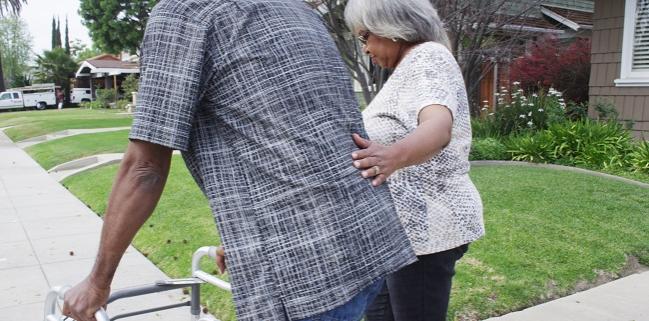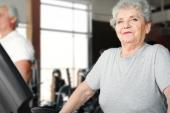LITE: High- Beats Low-Intensity Exercise at Home for Improving PAD
While pain-free light walking had no impact on objective measures, both self-reported speed and distance increased.

High-intensity exercise, in which patients with PAD walk to the point of inducing ischemic pain, is more likely to improve 6-minute walk values than pain-free light walking, according to data from the home-based LITE trial.
Although the lower-intensity exercise group walked about 50% more during the study, their mean change in 6-minute walk distance at 1-year follow-up actually decreased from baseline by 6.4 meters, while those in the high-intensity group increased their distance by 34.5 meters.
“We've thought that it may be better to walk at a higher intensity, but evidence for that was shaky, and some recent studies that had shown that low intensity was just as good as high intensity were not very large studies,” said lead investigator Mary M. McDermott, MD (Northwestern University Feinberg School of Medicine, Chicago).
McDermott said LITE is the largest home-based walking exercise study to date in PAD patients and was unique in that almost all of the coaching was done over the phone on a weekly basis. Participants, whether randomized to light walking or high-intensity exercise, wore accelerometers on their hips when they did their assigned walking and uploaded data on exercise frequency, time, and intensity via a computer or tablet provided by the researchers. There also was a no-exercise control group.
She told TCTMD that it’s unclear why high-intensity exercise is more effective in improving measured walking gains, but hypothesized that it may trigger certain biologic processes, like inflammation, which in turn may cause favorable effects on blood flow, formation of small blood vessels, muscle growth, and mitochondrial activity. The study was published April 6, 2021, in JAMA.
I think it’s important that we don't make this seem discouraging to patients. Sahil Parikh
Commenting on the study, Sahil Parikh, MD (NewYork-Presbyterian/Columbia University Irving Medical Center, New York, NY), said he would have expected to see a dose-response effect where there was some benefit to light exercise and greater benefit to higher intensity exercise. Importantly, he added, patient-reported outcomes need to be considered in addition to the objective measure of the walk test. Although there was no significant difference in change in 6-minute walk distance between the low-intensity group and controls at 12 months, the low-intensity group did make improvements over controls in both distance and speed scores on the self-reported Walking Impairment Questionnaire (WIQ). Additionally, 67.4% of those in the low-intensity exercise group achieved at least 80% of their walking goal each week in the final month of the intervention versus only 55.7% of those in the high-intensity group.
“You have a situation where patients are feeling better but not performing better on the testing,” Parikh said. “I think it’s important that we don't make this seem discouraging to patients. Everybody who has PAD should be walking and exercising. If they're able to do high-intensity home exercise, that's great. If they can get to supervised exercise, that's great, too, but that's been limited because of COVID-19 restrictions where we are not having patients come in at all.”
In light of the pandemic, he added, “it's important to know, as this study shows, that high-intensity home therapy actually does work, but you have to prescribe the right regimen. High intensity clearly is superior to light intensity, but both are worth recommending to your patients with PAD. For patients who participate in a high-intensity program, it’s important for them to recognize that they are going to be getting a lot of benefit compared to doing nothing.”
Walking at Home With Support and Follow-up
The LITE trial randomized 305 PAD patients (48% female; 59% Black) to a high-intensity exercise, low-intensity exercise, or a nonexercise control group. For the first four weeks, all groups had weekly in-person visits. Beginning at week 5, the exercise groups were supervised by telephone coaches weekly and the control group was supervised by a staff member who provided education sessions on a variety of health topics each week over the telephone.
Participants in both exercise groups were asked to walk unsupervised at home five times per week for up to 50 minutes while wearing the accelerometers. The low-intensity group was instructed to walk at a pace without ischemic leg symptoms, while the high-intensity group was asked to walk at a pace that elicited moderate to severe symptoms.
All patients had follow-up in-person visits at weeks 26 and 52. Adherence to the protocol between weeks 5 and 52 were 84.6% in the high-intensity group, 85.1% in the low-intensity group, and 61.8% in the control group.
The low-intensity group exercised a mean of 3.5 days per week, for a mean total of 145 minutes per week, whereas the high-intensity group exercised a mean of 2.8 days and 77 mean total minutes per week. Compared with high-intensity participants, the low-intensity group hit their target exercise intensity more often over the course of the trial (92% vs 63%; P < 0.001).
Two study participants experienced serious adverse events: one in the low-intensity group after the baseline treadmill test and one in the high-intensity group. In both cases, coronary artery stenting was required.
More Work Needed to Understand Benefit
Prior work by McDermott’s group in the HONOR trial did not support home-based exercise with a wearable monitor and phone coaching for PAD. McDermott said the positive results seen in the LITE trial are likely related to more-frequent contact with patients. Additionally, patients in HONOR were told to walk to elicit leg pain, but the researchers had no way of knowing if patients were doing so, since they did not gather accelerometer data.
Only 47 of the 305 patients consented to calf muscle biopsy at the beginning and end of the LITE trial, which the researchers hoped might show differences across the three assigned groups. However, no differences were seen that would explain the advantage for the high-intensity group, McDermott noted.
“Something about inducing the ischemia is important in terms of getting the maximum benefit,” she said. “I think that if we could do a trial with more people getting muscle biopsies, and do different types of measures in the muscle biopsies like looking directly at mitochondrial activity with higher quality measures than what we used, . . . it might help us figure out what's going on.”
Something about inducing the ischemia is important in terms of getting the maximum benefit. Mary McDermott
Parikh said better biopsies might also be able to identify subpopulations who might benefit from exercise therapy and those who might be better off with revascularization.
Currently, the Centers for Medicare & Medicaid Services reimburse for supervised exercise for PAD, but not home-based programs.
“There is still this perception that supervised exercise is better than home-based in people with PAD. I don't believe that,” McDermott said. “ I think it's very important to try to get coverage for it, but I think honestly, we need to convince the community that home-based is just as good as, or better than, supervised exercise.”
Parikh said he’s not holding his breath just yet on a coverage decision without additional studies. “But certainly, that could be something to consider in terms of rewarding patients with PAD if they're part of a wellness program,” he explained. “There's a value-added return on investment for patients who work out and exercise the way it's instructed in [the LITE trial], and it would probably be cost saving to the health system in the future.”
L.A. McKeown is a Senior Medical Journalist for TCTMD, the Section Editor of CV Team Forum, and Senior Medical…
Read Full BioSources
McDermott MM, Spring B, Tian L, et al. Effect of low-intensity vs high-intensity home-based walking exercise on walk distance in patients with peripheral artery disease: the LITE randomized clinical trial. JAMA. 2021;325:1266-1276.
Disclosures
- McDermott reports research funding from Regeneron and other research support from Art Assist, HelixMith, Hershey Company, Mars Company, ReserveAge, and Chromadex for study interventions or measures not related to the LITE trial; and serving as deputy editor of JAMA, but not being involved in any of the decisions regarding review of the manuscript or its acceptance.
- Parikh reports institutional grant support/research contracts from Shockwave Medical, TriReme Medical, Surmodics, and Abbott Vascular; personal fees from Abiomed and Terumo Medical Corporation; and honoraria or fees for consulting or speaking to his institution from Boston Scientific, Medtronic, CSI, and Philips.




Comments